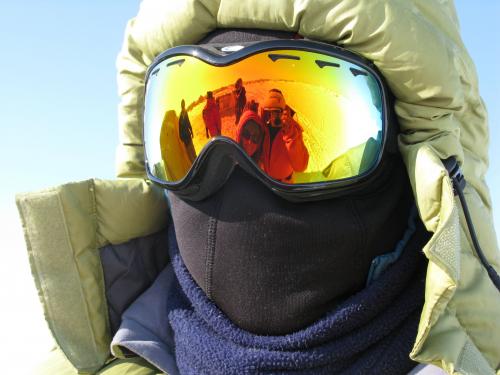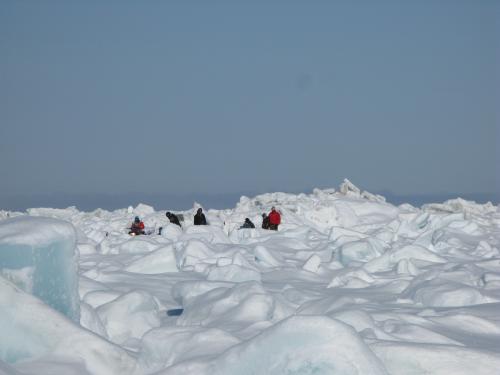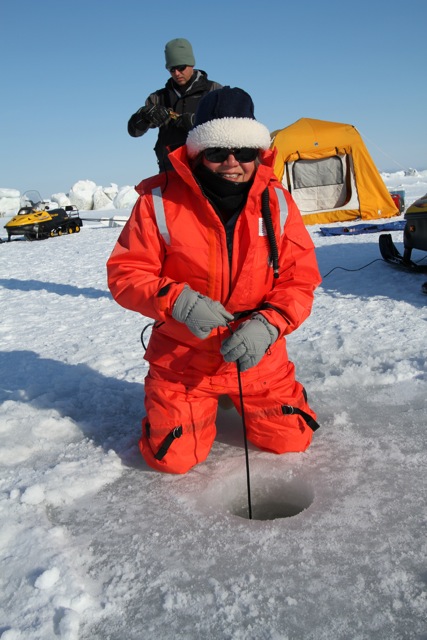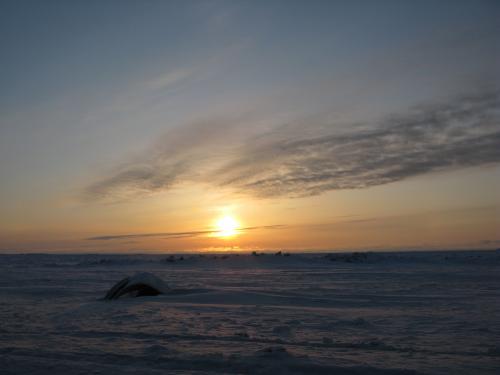
The bright sun was sparkling on the snow and ice as we wound our way through the intruding ridges of the frozen ocean. The temperature was -10 F when we set out, and the chill in the air was invigorating. As we made our bumpy way on the mile and a half trail to ice camp, the evidence of heavy ridging surrounded us.

By all accounts, everything went well with the sampling. Adriane and I spent most of the time working with the underwater cameras we both brought. Several of the UMIAQ team members helped us secure them; and Zac sat patiently on the ice lowering the Seaviewer cam until we reached the bottom while I monitored the progress on my computer. I captured some interesting organisms, as yet unidentified, and will post some video as soon as I can get more information on what we’re seeing. Tony (UMIAQ) was very excited when we reached the floor of the ocean. He said he had never seen it there before. I told him none of us had ever seen there before either ☺

An exciting thing happened this evening! Earlier Adriane and I were at the Inupiat Heritage Center when a call came in that there had been a strike on a whale. I put in a call later to Brower Frantz (UMIAQ project manager) to find out what was happening. He called me back and said that his cousin had brought in a whale! He was on his way to help bring it in and process it. As I sit here in the quiet of the hut looking out at the picture perfect “night”, I can only imagine the excitement and kinship happening at the water’s edge.
In the tradition of their ancestors, the Inupiat hunt whale for subsistence. Crews of men are camping at the water’s edge near leads now, the beginning of whaling season. Tents made of canvas provide shelter. The tents have a wooden floor and Styrofoam insulation to keep them warm. Whales are very sensitive to sight, sound and smell, so ice blocks are set up so that the whale can’t see the people or equipment! Men dress in white parkas to blend in with the ice as well. The women provide food to the hunters, and maintain an environment of harmony in all things to help “invite” the whale.
A captain and his crew still use the umiaq- the skin boats used by past generations of hunters. They’re light, quiet, and camouflage the men. Motorboats are only used to bring the whale in. Each crewmember has its own position in the umiaq according to their weight and strengths and they know exactly what to do as soon as the boats are put to sea.
All parts of the whale are systematically distributed to the captain, crew, families and the entire community, with specific parts of the whale going to each. By now, fresh maktak has been boiled and served to everyone on the ice in celebration of the successful hunt. Brower said the entire process would only take about 4 hours. He has promised us some pictures of the celebration. This is a special time for this community of family. As outsiders, we have to be invited into camp. I hope before the week is over that we can witness some of this rich cultural event in person.
“Whaling is our keepsake, given to us by our ancestors; it is our birthright and our destiny” Herbert O Anungazuk, Whaling Captain and Cultural Anthropologist



Comments